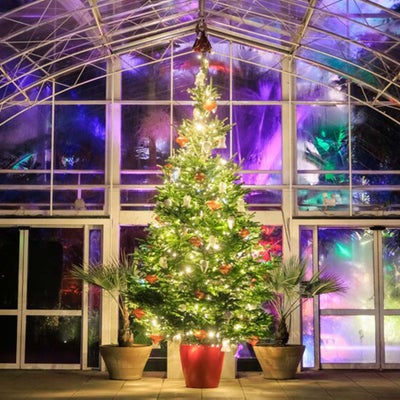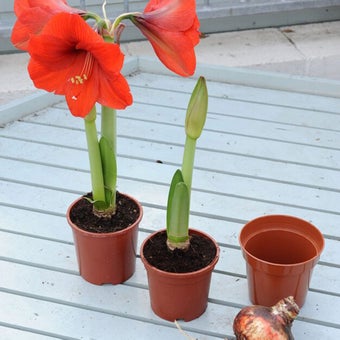
Quick facts
Common name - Christmas tree
Botanical name - Various
Group - Conifers
Height and spread - Depends on tree
Aspect - Most prefer a sheltered position, in full sun
Hardiness - Hardy
Difficulty - Easy
Christmas tree care
Remember to ask your supplier where the trees come from, and to choose a locally sourced and grown tree, or one that has at least been grown in the UK rather than abroad.
When displaying trees indoors, avoid placing them too close to a fire or radiator, as this will cause excessive moisture loss and needle drop.
Cut trees
- When you get the tree home, saw 2.5cm (1in) off the bottom with a pruning saw
- Place in a stand with a well of water in the base
- Check daily and top up the water when the level drops
- With care, cut trees should last about four weeks
Trees in pots
- To reduce stress and damage to living trees, display them in a cool room
- Bring trees indoors as late as possible – the weekend before Christmas is ideal
- Do not keep living trees in the house any longer than 12 days but be guided by the tree. If it looks unhappy, put it back outside
Either plant the tree out in the garden after Christmas, or (if you want to bring it indoors again next year) grow it on in a container, moving it into a bigger pot annually until you reach the maximum size that can be moved comfortably (about 45cm (18in) diameter and depth). Ideally use a peat-free John Innes No 2 potting .
Pruning, training and propagation
Christmas trees need very little training when grown outdoors. Aim to maintain an attractive shape, removing any shoots that spoil the silhouette or any strong upright branches that compete with the leading stem. Prune away any dead, diseased or dying branches.
Christmas trees planted in pots will be limited in their size by the constraints of the pot. But if planted out in the garden, Christmas trees can get very large, reaching a height of about 15-20m (50-65ft) in twenty years, and possible eventual heights of about 40m (130ft). The smallest growing Christmas trees are probably Fraser firs, which reach about 7m (23ft) after twenty years, attaining an eventual height of about 20m (65ft), and Korean firs, which reach 4m (13ft) in twenty years and an eventual height of 10m (33ft).
Propagation
Christmas trees can be grown from seed or cuttings - both semi-ripe and hardwood, but are usually bought as full size trees for displaying indoors.
Cultivar Selection
Picea abies(Norway spruce): Traditional Christmas tree with a good scent, but quick to drop its needles.
Abies nordmanniana(Nordmann fir): Dark green needles that are very slow to drop, but more expensive than Norway spruce.
Picea pungens Glauca group (blue spruce): Blue needles, more prickly than other trees, holds its needles better than the Norway spruce.
Abies koreana (Korean fir): Dark green, slightly curling needles. Excellent needle-holding quality.
Abies fraseri(Fraser fir): Good needle-holding properties, a lovely pine fragrance and the regular shape of a Norway spruce.
Alternative Christmas trees
There are many attractive options that can be used as alternatives to the traditional Christmas tree, including different dwarf conifers and pot grown specimens. Plant out in the garden post festivities or keep them in containers for reuse next Xmas.
Araucaria heterophyllaAGM(Norfolk Island pine)is an elegant, sparsely branched tree with distinctive rising tiers of branches. Grow as a houseplant all-year-round, since plants aren’t fully hardy outdoors. H. 2m x S. 1.5m
Standout feature: Unique arrangement of branches.
Picea abies ‘Wills Zwerg’is a very slow growing conical conifer with deep green evergreen foliage and a classic Christmas tree shape. Suitable for growing in containers and will eventually growing to H. 3m x S. 2m.
Standout feature: Perfect for pots
Picea glauca var. albertiana ‘Conica’ AGM is a slow-growing, cone-shaped evergreen conifer with a blue hue to its green needles. Suitable for growing in containers, eventually reaching H. 4m x S. 3m.
Standout feature: A classic Christmas tree in miniature.
Picea pungens ‘Fat Albert’ AGM is a dwarf conifer with a pyramidal habit of icy blue evergreen foliage. Suitable for container growing and will eventually reach H. 3m x S. 2.5m.
Standout feature: Glaucous (blue-green) needles.
Sciadopitys verticillata AGM(umbrella pine)has whorls of flattened needles ascending on stiffly upright branches. Slow growing habit that stays dwarf for a long time.
Standout feature: Unusual specimen for smaller gardens
Laurus nobilis ‘Little Ragu’(bay tree)is a compact, bushy form of this well-known herb. Use it as an aromatic festive tree and for adding leaves to flavour winter stews. H. 3m x S. 3m
Standout feature: Strongly aromatic leaves
Cryptomeria japonica ‘Elegans’ AGM(Japanese cedar) with gently weeping branches that hang with pillows of soft needles. Colours up well in autumn-winter flushing copper-bronze. H. 4 x S. 1.5m
Standout feature: Vibrant winter colour
Problems
Christmas trees are generally problem-free indoors but will lose their needles quickly if placed too close to a source of heat, or if water dries up in the well of the stand.
Christmas trees grown on in pots may only live for a few years, as they are not naturally suited to ongoing pot cultivation.
Sustainability
Not all trees are equal in terms of their environmental impact. Make your Christmas tree more sustainable by choosing an eco-friendly option.
While artificial trees can be reused year after year, sustainability wise they are low scorers due to their petroleum-based plastic construction and carbon emissions from transportation. Choosing a real tree, whether potted or cut, is greener when they are reused and recycled.
Real Christmas trees also have environmental benefits. A two-metre tree grows for approximately seven years before cutting. During this time they provide a habitat for wildlife, particularly birds, and capture carbon from the atmosphere.
Did you know: It’s estimated you’d need to use a synthetic tree for at least 10 years before it equalled the sustainability of a natural tree. However, disposal is still an issue, as it won’t readily recycle.
Greener options
- Keep your artificial tree going: If you already have an artificial tree, reuse it for as long as possible. This is a better choice than dumping it and buying a living tree
- Buy local: Source a locally grown tree, or at least one from the UK. Buy direct from the grower, preferably those which are grown without chemical use
- Potted trees: Container grown trees are a good option to plant in your garden after Christmas or pot up. Keep well-watered in a sunny spot for bringing indoors next December
- Rent a tree: Believe it or not, you can hire Xmas trees. This takes the hassle out of caring for it for the rest of the year. Try to find a company who are local to you
- Recycle your tree: Shred or make use of local collection schemes which turn it into or . It could even be donated to zoos for habitat creation or used for stabilising dunes
- Check websites for local options.




